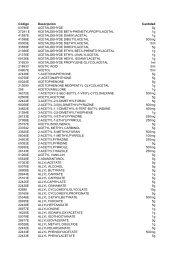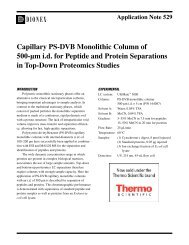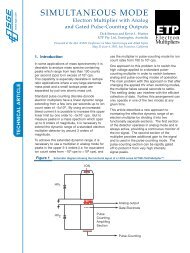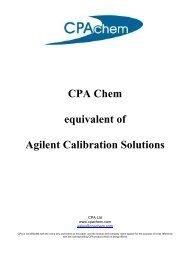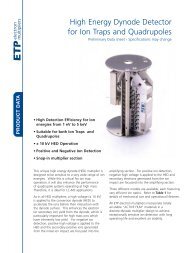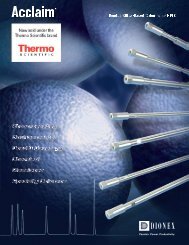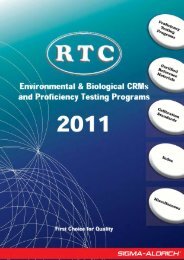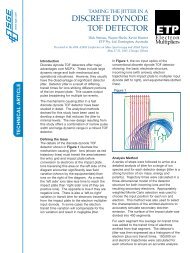Product Manual for Dionex IonPac AS23 Columns - Cromlab
Product Manual for Dionex IonPac AS23 Columns - Cromlab
Product Manual for Dionex IonPac AS23 Columns - Cromlab
Create successful ePaper yourself
Turn your PDF publications into a flip-book with our unique Google optimized e-Paper software.
<strong>Product</strong> <strong>Manual</strong> <strong>for</strong> <strong>IonPac</strong> <strong>AS23</strong> amd <strong>IonPac</strong> AG23 <strong>Columns</strong> Page 30 of 32ContaminationHydrophilicContamination of LowValenceA.4.1 Choosing the Appropriate Cleanup SolutionSolutionConcentrated carbonate solutions such as a 10X concentrate of the most concentrated eluent used in theapplication is sufficient to remove hydrophilic contamination of low valence.High ValenceHydrophilic IonsContaminationMetal ContaminationConcentrated acid solutions such as 1 to 3 M HCl will remove high valence hydrophilic ions by ionsuppression and elution by the chloride ion.Metal contamination often results in asymmetric peak shapes and/or variable analyte recoveries. Forexample, iron or aluminum contamination often results in tailing of sulfate and phosphate. Aluminumcontamination can also result in low phosphate recoveries.Concentrated acid solutions such as 1 to 3 M HCl remove a variety of metals. If after acid treatment, thechromatography still suggests metal contamination, treatment with chelating acids such as 0.2 M oxalic acidis recommended.Nonionic andHydrophobicContaminationOrganic solvents can be used alone if the contamination is nonionic and hydrophobic. The degree ofnonpolar character of the solvent should be increased as the degree of hydrophobicity of the contaminationwithin the range of acceptable solvents.Ionic and HydrophobicContaminationConcentrated acid solutions such as 1 to 3 M HCl can be used with compatible organic solvents to removecontamination that is ionic and hydrophobic. The acid suppresses ionization and ion exchange interactionsof the contamination with the resin.A frequently used cleanup solution is 200 mM HCl in 80% acetonitrile. This solution must be madeimmediately be<strong>for</strong>e use because the acetonitrile will decompose in the acid solution during long term storage.A.4.2 Column Cleanup ProcedureUse the following cleanup procedures to clean the AG23 and <strong>AS23</strong>.a) Prepare a 500 mL solution of the appropriate cleanup solution using the guidelines in, "Choosing theAppropriate Cleanup Solution".b) Disconnect the ASRS ULTRA II, AAES, or AMMS III from the <strong>IonPac</strong> <strong>AS23</strong> Analytical Column.c) If your system is configured with both a guard column and an analytical column, reverse the order of theguard and analytical column in the eluent flow path.d) Double check that the eluent flows in the direction designated on each of the column labels.When cleaning an analytical column and a guard column in series, ensure that the guard column isplaced after the analytical column in the eluent flow path. If not, the contaminants that haveaccumulated on the guard column can be eluted onto the analytical column and irreversibly damage it.CAUTIONIf in doubt, clean each column separately.e) Set the pump flow rate to 1.0 mL/min <strong>for</strong> an <strong>AS23</strong> 4-mm Analytical or Guard Column or set the pump flowrate to 0.25 mL/min <strong>for</strong> an <strong>AS23</strong> 2-mm Analytical or Guard Column.f) Rinse the column <strong>for</strong> 10 minutes with deionized water be<strong>for</strong>e pumping the chosen cleanup solution overthe column.g) Pump the cleanup solution through the column <strong>for</strong> at least 60 minutes.h) Rinse the column <strong>for</strong> 10 minutes with deionized water be<strong>for</strong>e pumping eluent over the column.i) Equilibrate the column(s) with eluent <strong>for</strong> at least 60 minutes be<strong>for</strong>e resuming normal operation.j) Reconnect the ASRS ULTRA II, AAES, or AMMS III to the <strong>AS23</strong> Analytical Columnk) Place the guard column in line between the injection valve and the analytical column if your system wasoriginally configured with a guard column.Document No. 065120-05 ©2012 Thermo Fisher Scientific July 2012




